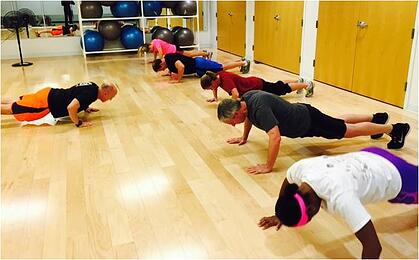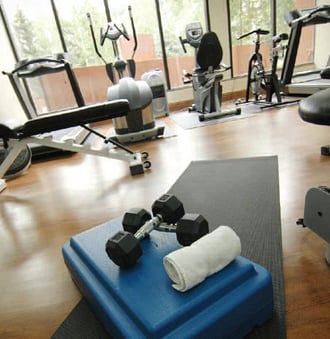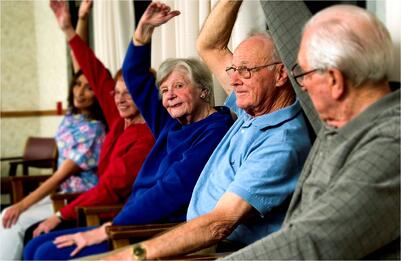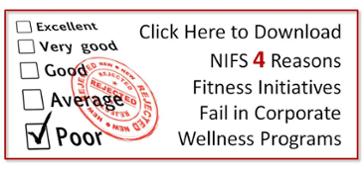 NIFS isn't the only agency that provides fitness management expertise to businesses. There are several like us because the market demands it. While many organizations have adopted a DIY attitude about managing their own fitness programs, an additional (and substantial) set of businesses has recognized the value in outsourcing fitness center management for their corporate fitness center or in their senior living community.
NIFS isn't the only agency that provides fitness management expertise to businesses. There are several like us because the market demands it. While many organizations have adopted a DIY attitude about managing their own fitness programs, an additional (and substantial) set of businesses has recognized the value in outsourcing fitness center management for their corporate fitness center or in their senior living community.
We’ve been at this for almost 25 years and I’ve heard a variety of objections to outsourcing fitness staff. I’ve got my own list of objections to those objections...so here we go:
Objection 1: Outsourcing fitness center management is too expensive.
This objection really comes down to a comparison of direct versus indirect employee costs. Working with a partner may be more expensive when you compare wages and benefits you pay your employee with the billing you would get from a partner. The fitness management organization has overhead and a margin they need to earn.
When you look at the cost to hire, train, and supervise an employee, your cost comparison starts to even out. Then throw in the consideration of ongoing training and supervision, potential turnover, and statutory costs related to employees, you may find that partnering with a staffing agency like NIFS provides significant value.
Objection 2: I have no control over the staff person.
I don’t know who you’ve worked with historically, but any organization in this business that doesn’t put service first and foremost is making a gigantic mistake. When you’re working with the right outsourcing partner, that organization should be keenly interested in keeping you, the client, happy. To that end, they should be very interested in your feedback about the strengths and weaknesses of the staff they’re providing at your location.
Objection 3: An outsourced staff person won’t have buy-in from our constituents.
For starters, see objection #2. Keep in mind that the only way a staffing agency stays in business is if they have learned to be nimble and highly adaptive to a variety of environments. You can check on a potential outsourcing partner’s flexibility by talking to a variety of references.
When we go to work in senior living settings, we often pair up staffing services with wellness consulting (at no additional cost) so that we can better support the organization and further understand the culture with that client. This understanding is communicated to our staff on the ground so that we’re all operating from the same educated starting point.
Objection 4: Fitness isn’t rocket science; we’ve got this.
Okay. You’re right. Fitness isn’t rocket science, and you may very well “have it.” There are a host of highly capable, service-minded, passionate health and fitness professionals out there who are ready to work directly for you. But who has their back?
Who provides them with fresh ideas, resources, direction, and support? Your human resources director? Your activities director? Not likely—unless you’ve somehow hit a gold mine of fitness-educated staff at your business, the fitness manager you employ is probably the only one of his or her kind in your four walls. Outsourcing partners (the best ones, anyway) bring a team of resources, professionals, expertise, and support to the staff member they provide your organization.
Maybe you have other objections I can address. If so, leave them in the comments below. On the other hand, if I’ve just addressed your objections and you’re ready to start looking at outsourcing partners, drop me a line, or take a closer look at us through the rest of our blog. If your business has to move through an RFP process, you might want to read what I wrote on my top 10 RFP questions for corporate fitness management.
CORPORATE FITNESS STAFFING ›SENIOR LIVING FITNESS STAFFING ›


 When a business makes the commitment to put in a corporate fitness center, they are making a statement (hopefully one of many) about how important their employees’ health is. It’s a substantial investment, and the project is not to be taken lightly.
When a business makes the commitment to put in a corporate fitness center, they are making a statement (hopefully one of many) about how important their employees’ health is. It’s a substantial investment, and the project is not to be taken lightly. 


 There’s been a lot in the media lately about wearable technology having a strong presence in corporate wellness. Employee wellness programs have
There’s been a lot in the media lately about wearable technology having a strong presence in corporate wellness. Employee wellness programs have 
 At NIFS, we work in both
At NIFS, we work in both  Lasalle Pinnock joined the corporate wellness center in July when his department moved. Almost immediately he scheduled an exercise prescription with the NIFS Fitness Management staff and has been following that exercise program ever since. He started with a few days of strength training and cardiovascular exercise. After about a month he came to the staff looking to add one more day of activity to his routine. Each week he updates us on his progress not only with weight lost but how he is improving in stamina and strength. Because of his dedication to exercise he has also been motivated to make healthier choices when it comes to his diet and started sharing the things he’s learned with his wife.
Lasalle Pinnock joined the corporate wellness center in July when his department moved. Almost immediately he scheduled an exercise prescription with the NIFS Fitness Management staff and has been following that exercise program ever since. He started with a few days of strength training and cardiovascular exercise. After about a month he came to the staff looking to add one more day of activity to his routine. Each week he updates us on his progress not only with weight lost but how he is improving in stamina and strength. Because of his dedication to exercise he has also been motivated to make healthier choices when it comes to his diet and started sharing the things he’s learned with his wife. fast food, fried, and greasy foods. If I’m unable to eat a healthy meal I make sure I eat a smaller portion. Instead of getting sodas or chips from the vending machine I grab trail mix or eat some type of fruit. I have noticed since working out I have so much more stamina, energy, and I am less tired during the day. I can really feel and see the difference in my mood and body. Mentally I feel more focused and less stressed, I just feel great. Right now my goal is to stay focused and to keep moving forward. I want to reach my target weight and inspire others.
fast food, fried, and greasy foods. If I’m unable to eat a healthy meal I make sure I eat a smaller portion. Instead of getting sodas or chips from the vending machine I grab trail mix or eat some type of fruit. I have noticed since working out I have so much more stamina, energy, and I am less tired during the day. I can really feel and see the difference in my mood and body. Mentally I feel more focused and less stressed, I just feel great. Right now my goal is to stay focused and to keep moving forward. I want to reach my target weight and inspire others.